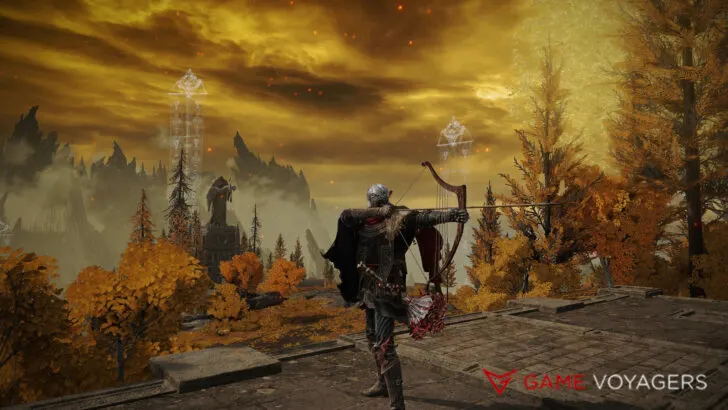Bows often get overlooked in Elden Ring due to their relatively low DPS and lack of excitement compared to other ranged options like Ashes of War or spells. With the Shadow of the Erdtree, bows have become more viable, with specific talismans and buffs that enhance their performance.
In this article, we have compiled a tier list for all the 19 bows in Elden Ring, from worst to best, based on their overall performance and usefulness in PvE scenarios.
D Tier Bows
These are the bottom-of-the-barrel bows in Elden Ring that have better alternatives. Better to avoid these bows altogether:
Harp Bow
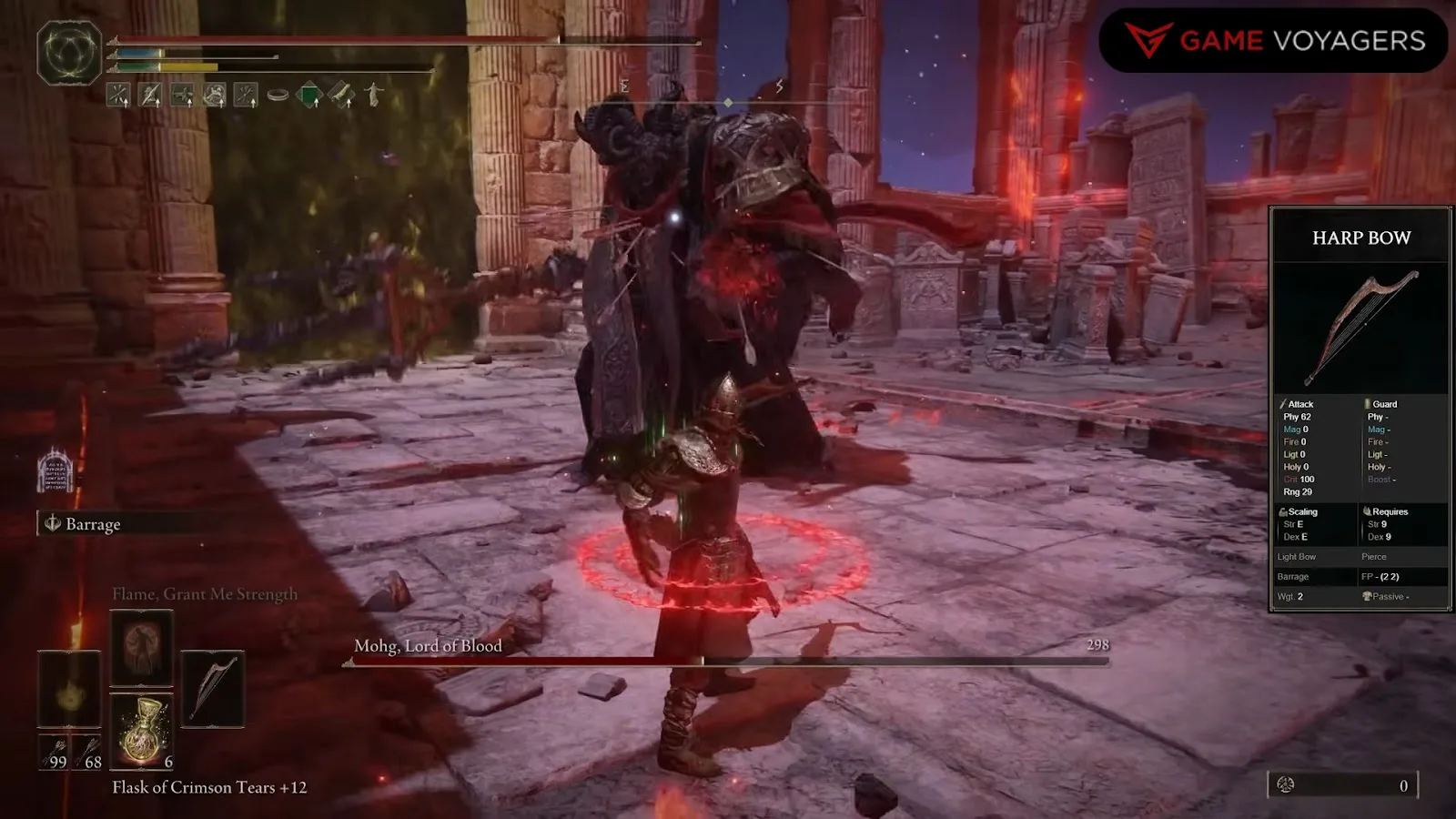
At the bottom of the list is the Harp Bow, the weakest bow in Elden Ring in terms of damage. This short bow is non-infusible and comes with the Barrage skill. While Barrage is decent for proccing status effects, it can also be used with virtually every other bow, making the Harp Bow a less appealing choice. Using this skill with a medium bow, for example, yields far better results.
The one advantage of the Harp Bow is that it is the lightest bow in the game and has the lowest stat requirements. However, these benefits are marginal, as the reduction in weight and requirements does not compensate for its significantly lower damage output.
In most cases, investing slightly more into Dexterity to use options like the Shortbow or Composite Bow is the better recourse. To make matters worse, the Harp Bow becomes available only later in the game, at which point better options are already available.
Red Branch Shortbow
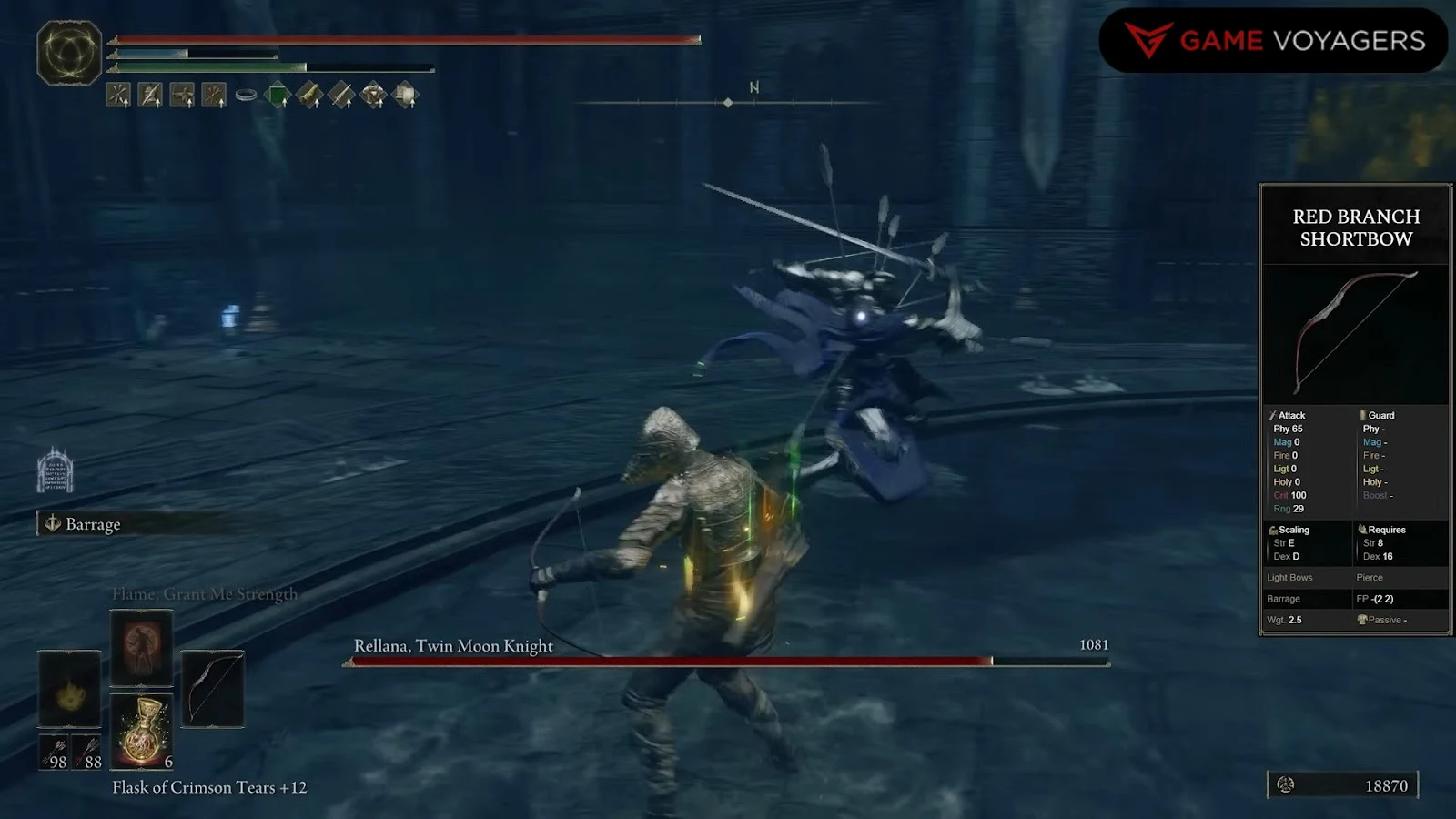
The Red Branch Shortbow is an infusible bow that scales best with Dexterity. Unfortunately, it is outclassed in nearly every way by the Composite Bow. Although the Composite Bow weighs slightly more (by just half a unit), it is obtainable much earlier in the game and offers better damage output.
While the Red Branch Shortbow has a lower Strength requirement (only 8 compared to the Composite Bow’s 15), bows are typically wielded two-handed, effectively halving the Strength requirement. This means the Composite Bow requires only 10 Strength, and nearly all builds in the game will have at least that much Strength.
Adding to its downsides, acquiring the Red Branch Shortbow involves an annoying farming process of killing the Page enemies found only in a few areas late in the game, like Leyndell Royal Capital, making it a poor choice compared to the Composite Bow.
Shortbow
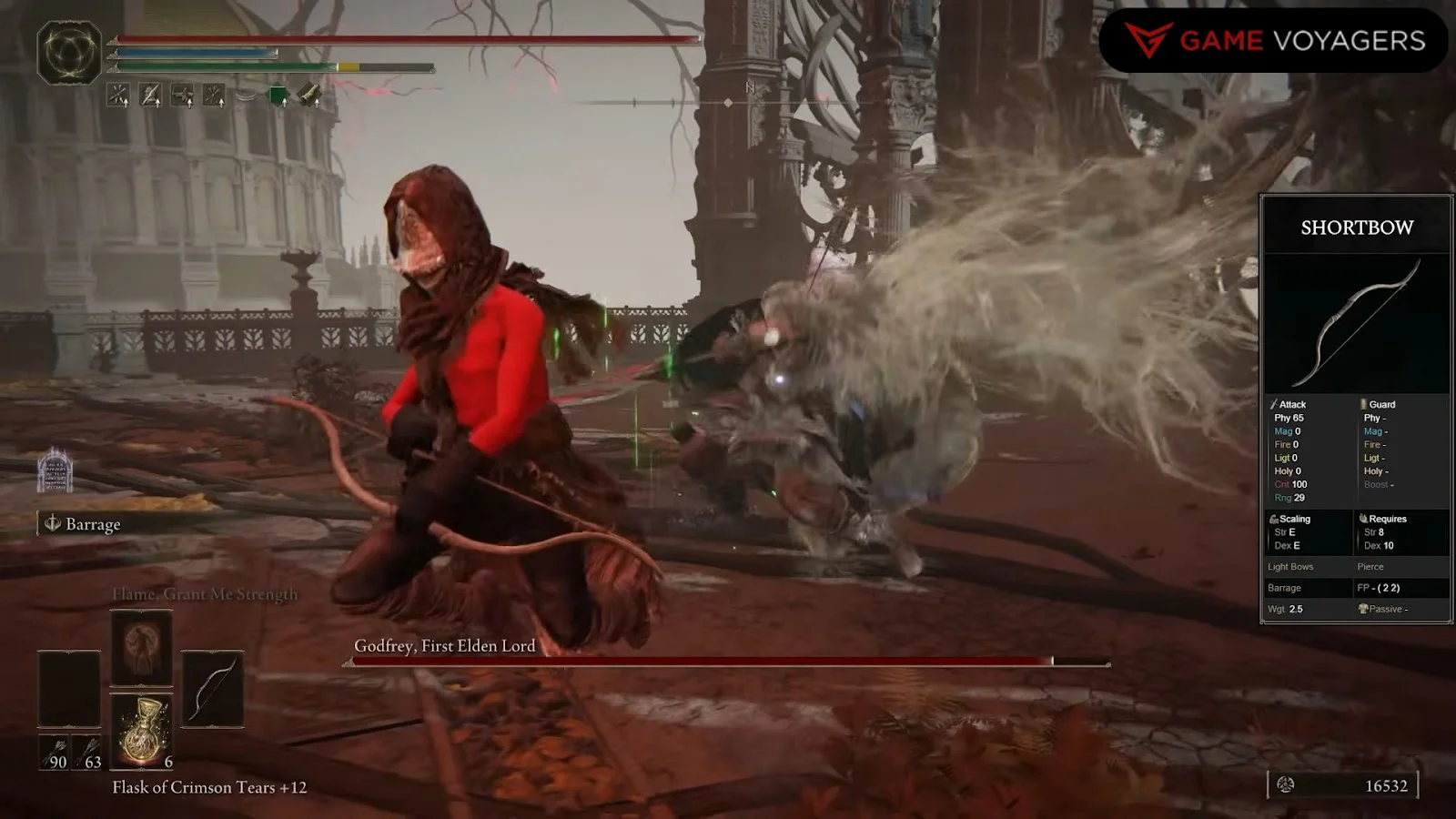
The Shortbow is another infusible light bow, and while it features Quality scaling (Strength and Dexterity), the scaling itself is mediocre. At higher levels, it performs worse than all other infusible light bows.
Like the Red Branch Shortbow, the Shortbow is ultimately outclassed by the Composite Bow. Investing just two additional points into Strength allows you to use the Composite Bow, which offers significantly better performance.
That said, the Shortbow avoids being placed at the bottom of this ranking because it is available very early (starting) in the game, providing players with immediate access to the much more agile light bow moveset.
C Tier Bows
The following bows work better than the previous tier and function stronger when playing into their narrow niche. The bows are situational and lack versatility:
Serpent Bow
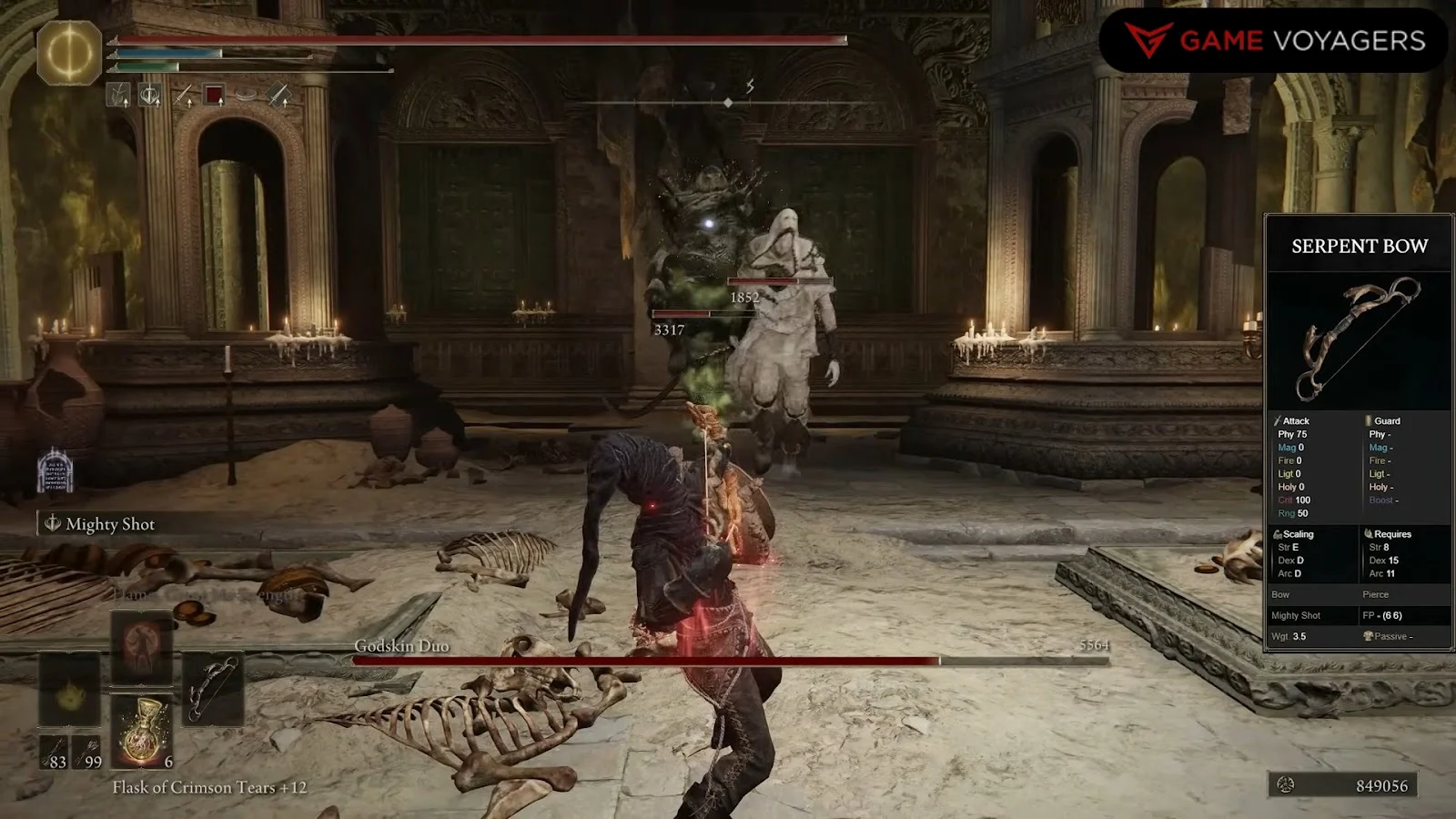
The Serpent Bow is technically a medium bow, but its actual small size suggests otherwise. Also, its primary purpose, which is to apply a status effect, would have significantly benefited from a light bow’s faster moveset. The Serpent Bow is held back by its low damage, inability to be infused, and lackluster weapon skill (Mighty Shot).
One of its key features is its Arcane scaling. However, this scaling only increases status effect buildup and does not improve the bow’s damage output. While it can enhance poison buildup with each shot, the increase is minimal and only stacks with the poison from the arrows themselves.
You would think the Arcane scaling would help apply other arcane-related status effects like Bleed and Sleep, but you’d be wrong. It only boosts poison! Furthermore, the poison inflicted by this bow is regular poison, not deadly poison, which deals minimal damage over time.
Incantations like Poison Mist are far superior for faster and more efficient poison application, consuming less FP and dealing area-of-effect damage.
Ultimately, the Serpent Bow’s niche utility and poor performance make it a highly situational weapon at best.
Horn Bow
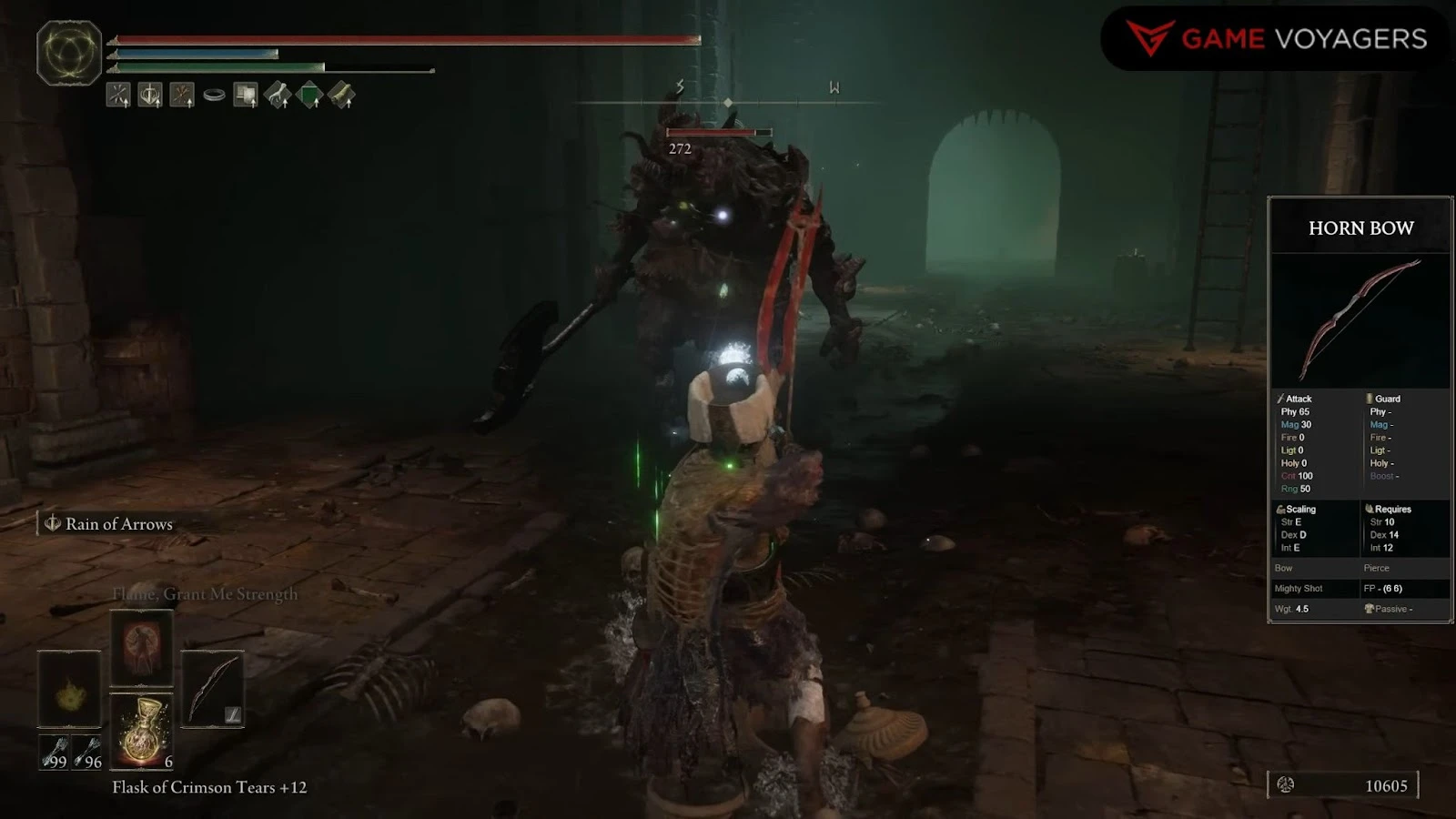
The Horn Bow is a medium bow that deals split magic and physical damage, meaning that all arrows fired from it will include a small amount of magic damage regardless of the arrow type. Its primary niche is using magic-based arrows, as the bow’s split damage aligns well with such setups.
This bow has a minor Intelligence scaling, but the scaling is very weak, offering negligible damage boosts even for INT builds. If you stack various magic buffs, it has the potential to become one of the highest-damaging (if not the highest-damaging) medium bows in the game, but that just takes so much effort.
The Horn Bow’s most viable role is as a sniping tool for Intelligence builds. However, such builds typically have access to sniping spells that are more effective than the Horn Bow. As a result, its overall utility is limited, and it remains the only option for players seeking a magic-themed bow.
Igon’s Greatbow
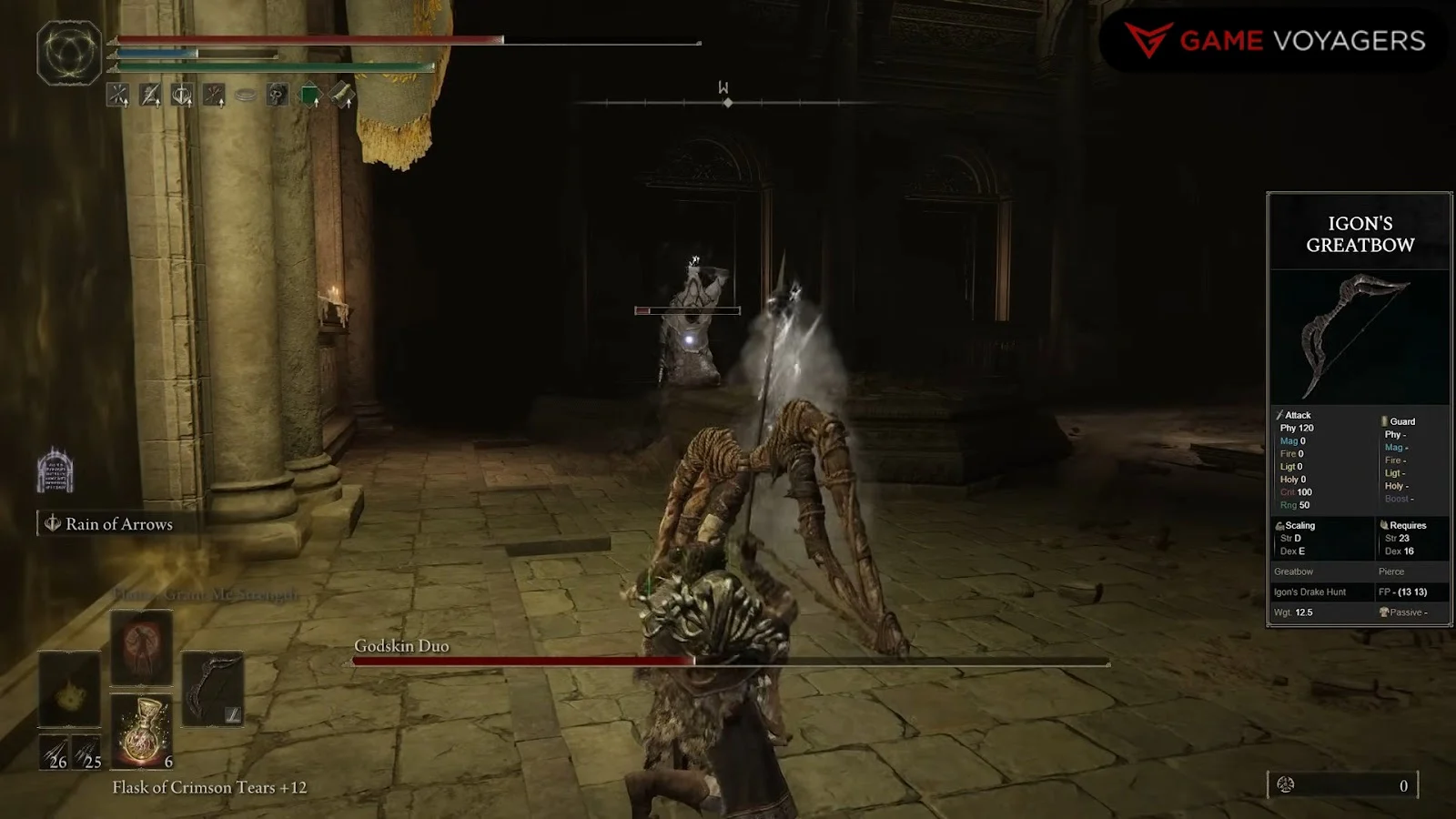
Igon’s Greatbow, introduced in the Shadow of the Erdtree, is one of the two infusible greatbows in the game, the other being the regular Greatbow. Igon’s Greatbow boasts better Strength scaling compared to the standard Greatbow. However, the regular Greatbow can out-damage Igon’s Greatbow at higher levels if you have even a slight Dexterity investment.
Given that Igon’s Greatbow is locked behind one of the most challenging bosses of the DLC, Bayle, it’s likely that by the time you obtain it, you’ll already be at a level where the regular Greatbow is superior. If you want a Strength-based greatbow, the Golem’s Greatbow is an even better option for raw damage, though it cannot be infused.
This bow has a unique niche if you want to use the Rain of Arrows skill. However, even in this case, Radahn’s Greatbow offers a superior version of Rain of Arrows (Ash of War), making it hard to justify choosing Igon’s Greatbow. Ultimately, it lacks a compelling reason to stand out among its competitors.
Erdtree Greatbow
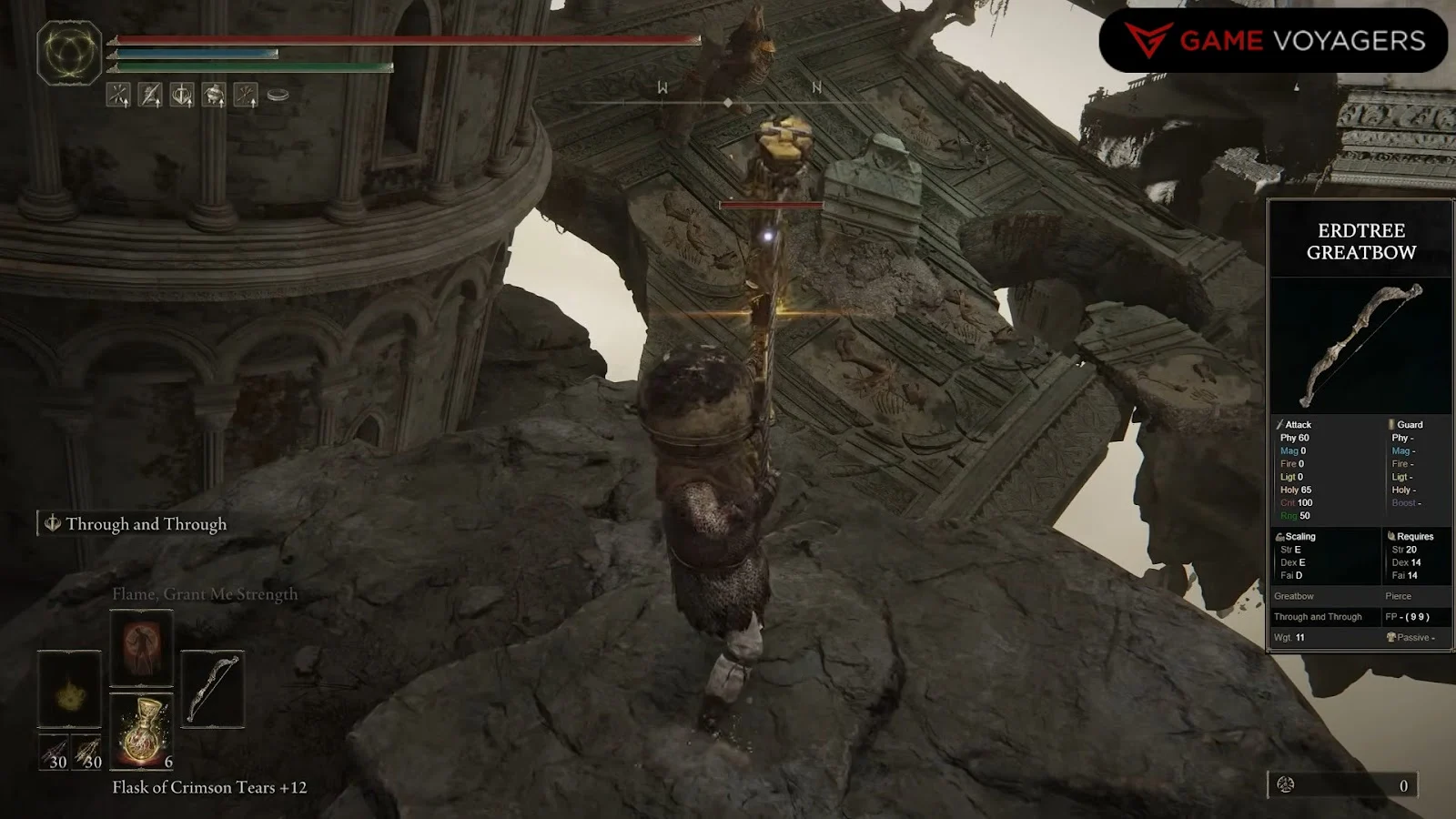
The Erdtree Greatbow is a faith-based weapon with split Holy damage. This means it will always deal a portion of its damage as Holy, making it most effective when paired with a Faith-based build and specific arrows like Golden Arrows. Outside of this particular setup, the bow’s damage output is underwhelming, especially compared to other greatbows like the Golem’s Greatbow.
One significant drawback is that most enemies in the game have resistance to Holy Damage. However, the Erdtree Greatbow can serve as a sniper in a Faith build, allowing you to pick off enemies from a distance with headshots.
A unique feature of the Erdtree Greatbow is that hitting allies or yourself with Golden Arrows applies a buff similar to the Golden Vow effect. While this is a nice touch, it’s somewhat redundant, as most Faith builds already have access to the Golden Vow spell, which applies a more robust version of the buff.
The inability to infuse the Erdtree Greatbow or swap its weapon skill also limits its flexibility. Unfortunately, these missed opportunities make the Erdtree Greatbow feel less versatile than it could have been.
Erdtree Bow
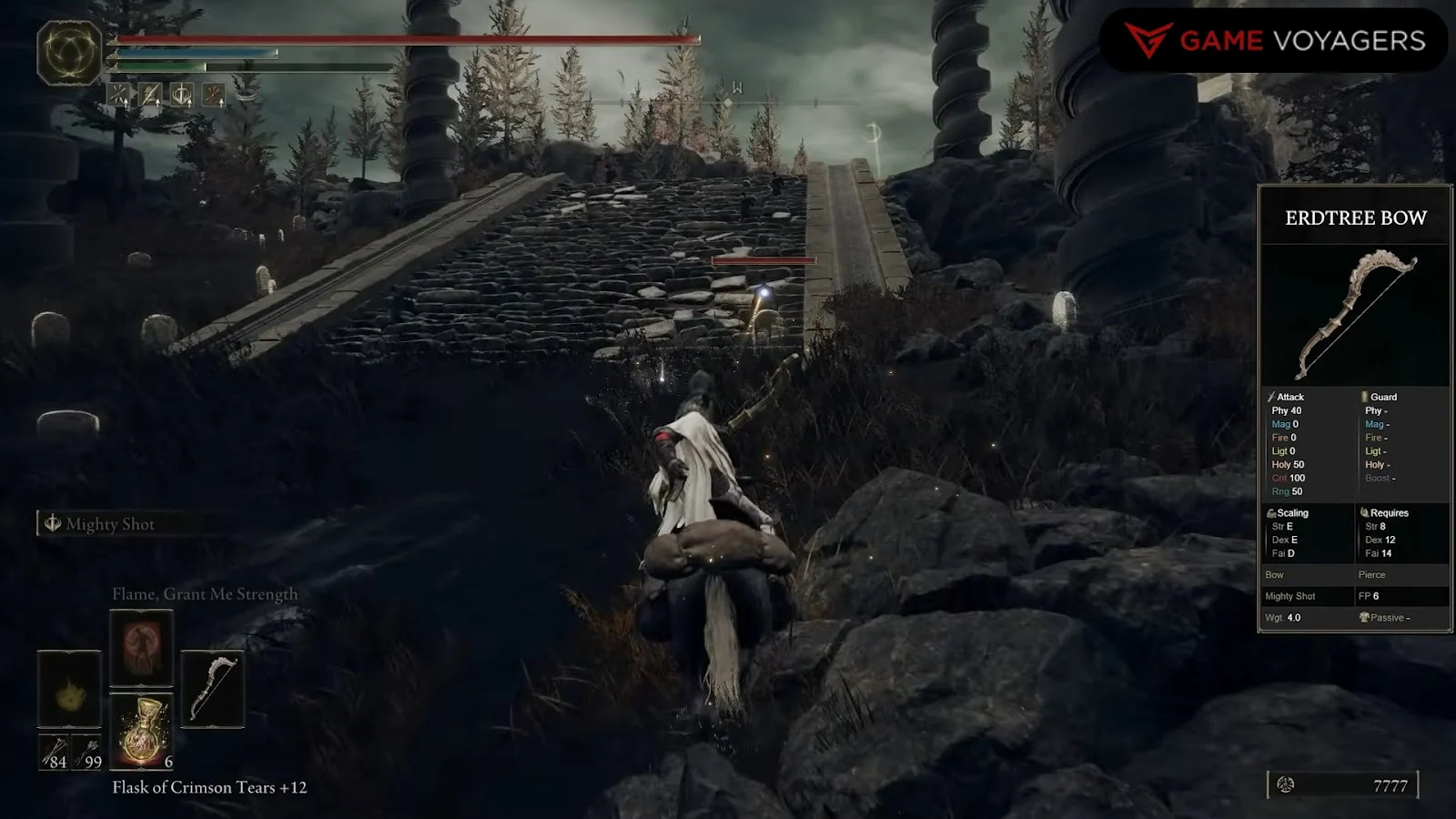
Like the Erdtree Greatbow, the Erdtree Bow is another Faith-scaling weapon with split Holy damage. This bow can potentially deal some of the highest damage in its class but only when used with a Holy-focused build. Despite this potential, Holy damage is generally underwhelming in the base game, limiting its overall effectiveness.
When paired with Golden Arrows, the Erdtree Bow gains a noticeable damage boost, and further investment into Faith amplifies its Holy damage output.
Its primary utility lies in dungeon and catacomb exploration, where it can quickly dispatch skeleton enemies without consuming FP. However, many Faith-based spells can achieve the same results at minimal FP cost, making the bow’s role less unique.
The Erdtree Bow’s lack of infusion options and being stuck with Mighty Shot further restrict its potential. Allowing it to use other skills would have greatly increased its viability, particularly against Holy-weak enemies. As it stands, it’s a decent option for Faith builds, but it doesn’t rise above its limitations.
B Tier Bows
Now, these bows can be considered as a trusty “sidearm.” You can’t expect them to shred bosses, but you can whip them out reliably. With them, you can mix in some long-range action into your combat in Elden Ring:
Misbegotten Shortbow
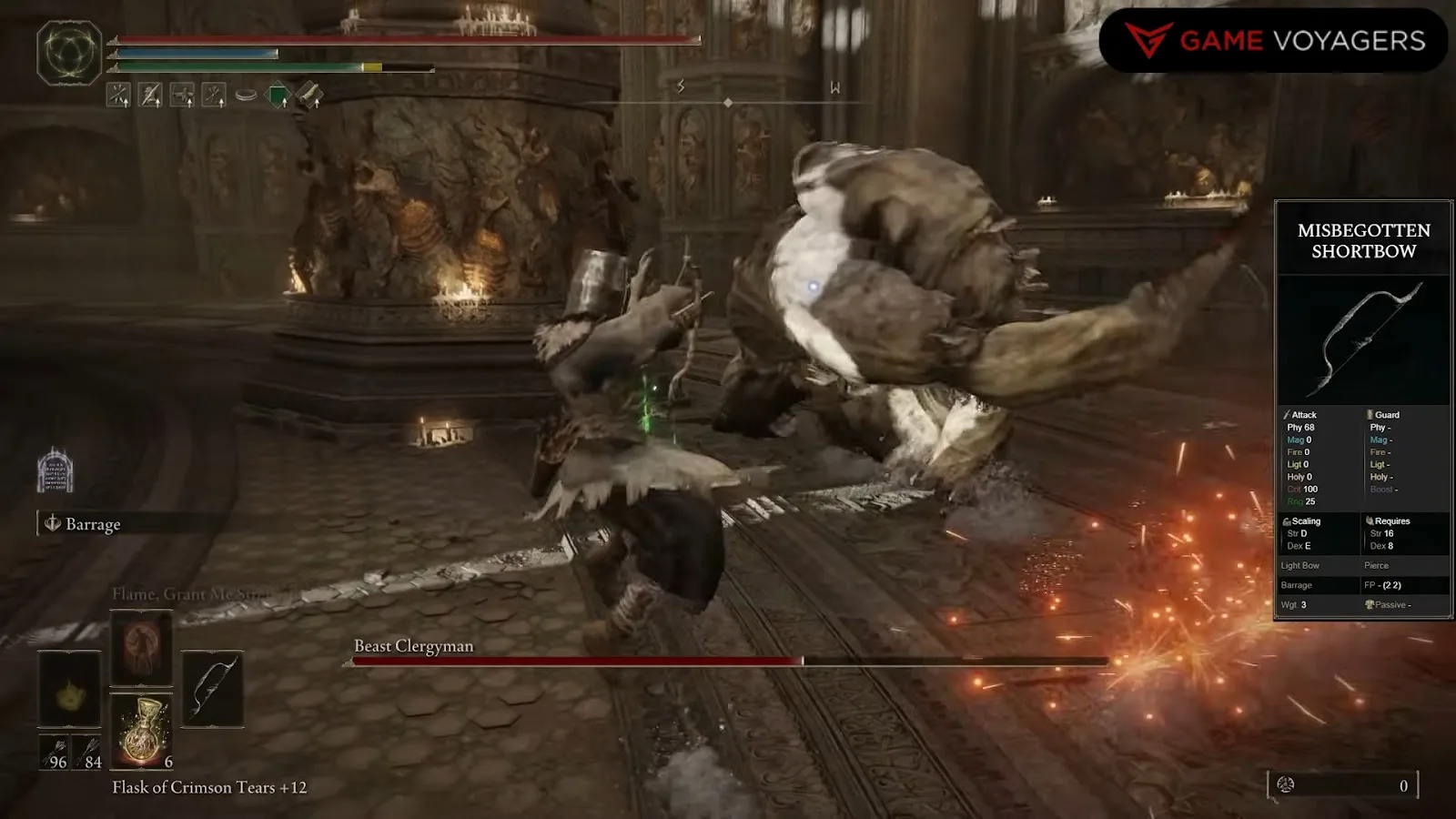
The Misbegotten Shortbow is an infusible light bow with the highest damage in its category. Its scaling is Strength-focused, which is unusual for a bow. Generally, Dexterity-based bows are more synergistic because Strength builds typically have access to other projectile options.
Despite its significant damage, the Misbegotten Shortbow suffers from the shortest range among all shortbows. This is a significant drawback, as bows experience noticeable damage falloff at range. Even at relatively short distances, the damage falloff becomes apparent, making this bow less effective in real-world scenarios.
In reality, other light bows (particularly the Composite Bow) outperform the Misbegotten Shortbow when the range is a factor. Still, the Misbegotten Shortbow is a viable option early in the game, though it requires farming those ugly Misbegotten enemies to obtain.
Albinauric Bow
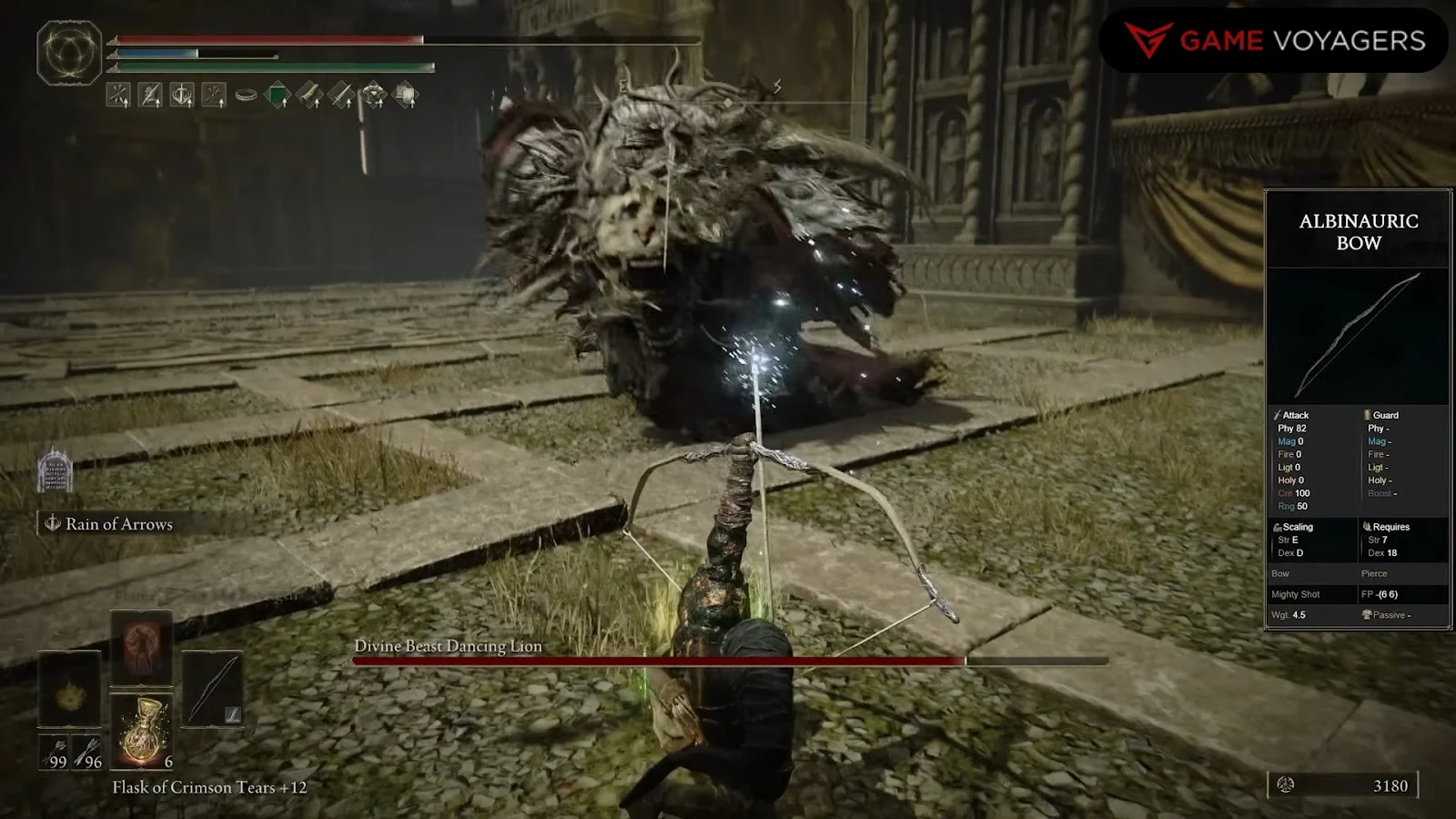
The Albinauric Bow is one of two infusible medium bows, the other being the Longbow. While this bow has greater damage, it is held back by the general limitations of infusible medium bows, which lag behind other bow types in terms of raw damage potential.
One of its strengths lies in its flexibility. The freedom to swap between skills like Rain of Arrows and Mighty Shot gives it more utility than many other bows.
However, acquiring the Albinauric Bow is tedious, requiring farming Albinauric Archers in the Consecrated Snowfield. This makes it much harder to obtain than the Longbow, which is available early in the game without any farming.
Given that the Longbow’s damage is only slightly lower, its accessibility makes it a more practical choice for most players. If you’re willing to go through the effort, the Albinauric Bow is a direct upgrade and the best infusible medium bow available. Still, its marginal advantages may not justify the time investment for many players.
Longbow
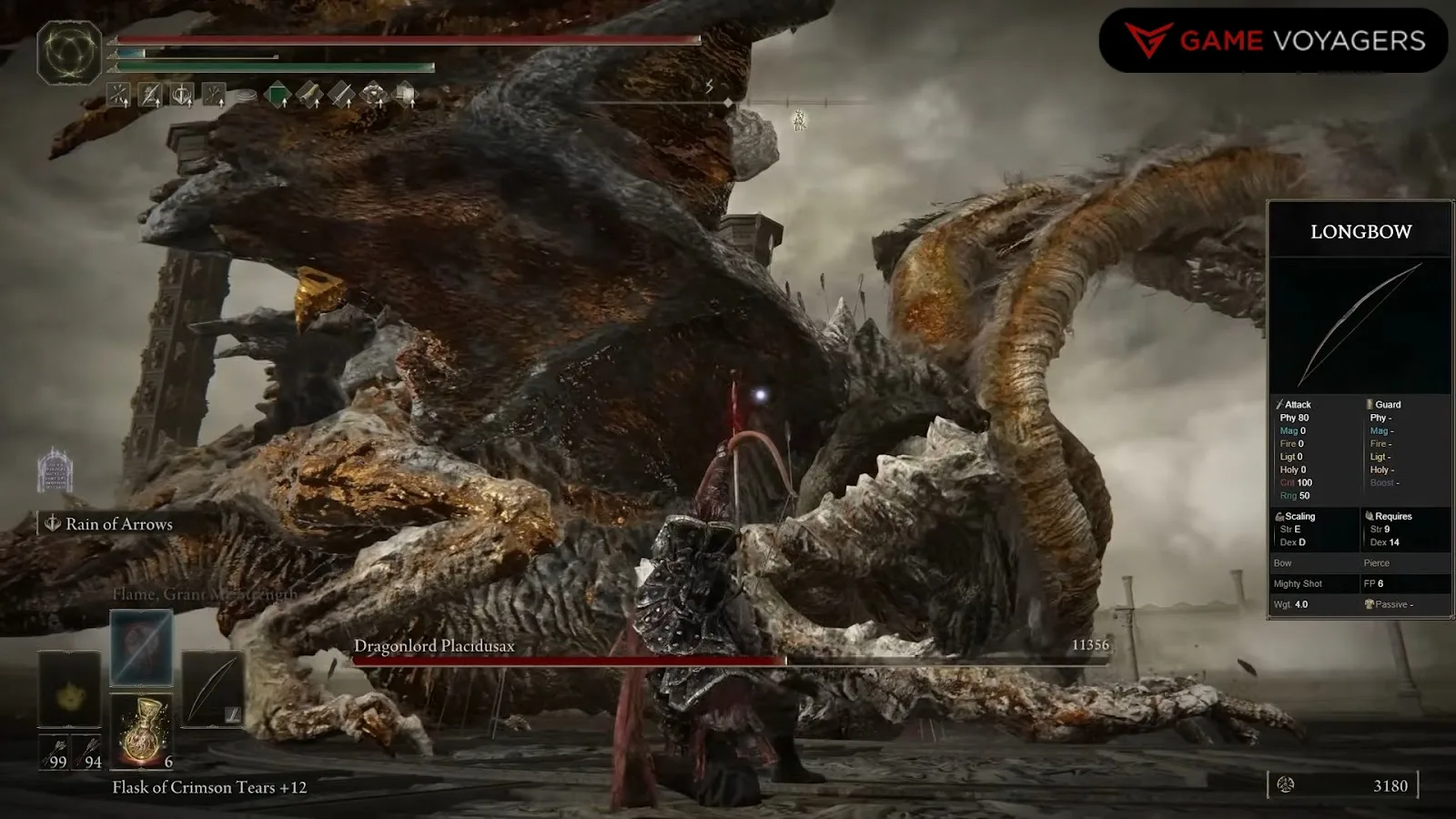
The Longbow is an infusible regular bow you can acquire right at the start of the game (Samurai starting weapon). I’m not the biggest fan of medium bows compared to light or great bows, mainly because in 1v1 fights, I prefer the light bow’s faster moveset, which results in higher DPS and quicker status effect buildup.
Medium bows, on the other hand, do offer more damage through skills like Mighty Shot and Rain of Arrows. However, when using bows for giant boss fights or sniping, greatbows surpass medium bows. Greatbows not only have better range and more damage, but they also have their sniping skills, giving them a significant edge over medium bows.
Of course, greatbows come with higher stat requirements and weigh much more, so if you don’t want to invest heavily in stats or deal with the weight, medium bows like the Longbow can be a convenient alternative.
Ultimately, the Longbow’s forte is its balance. It doesn’t require heavy investment and provides an excellent middle ground between range and damage, though it can’t compete with greatbows in raw power. Its utility lies in its convenience, providing a functional sniping option without needing specialized builds for heavier weaponry.
Black Bow
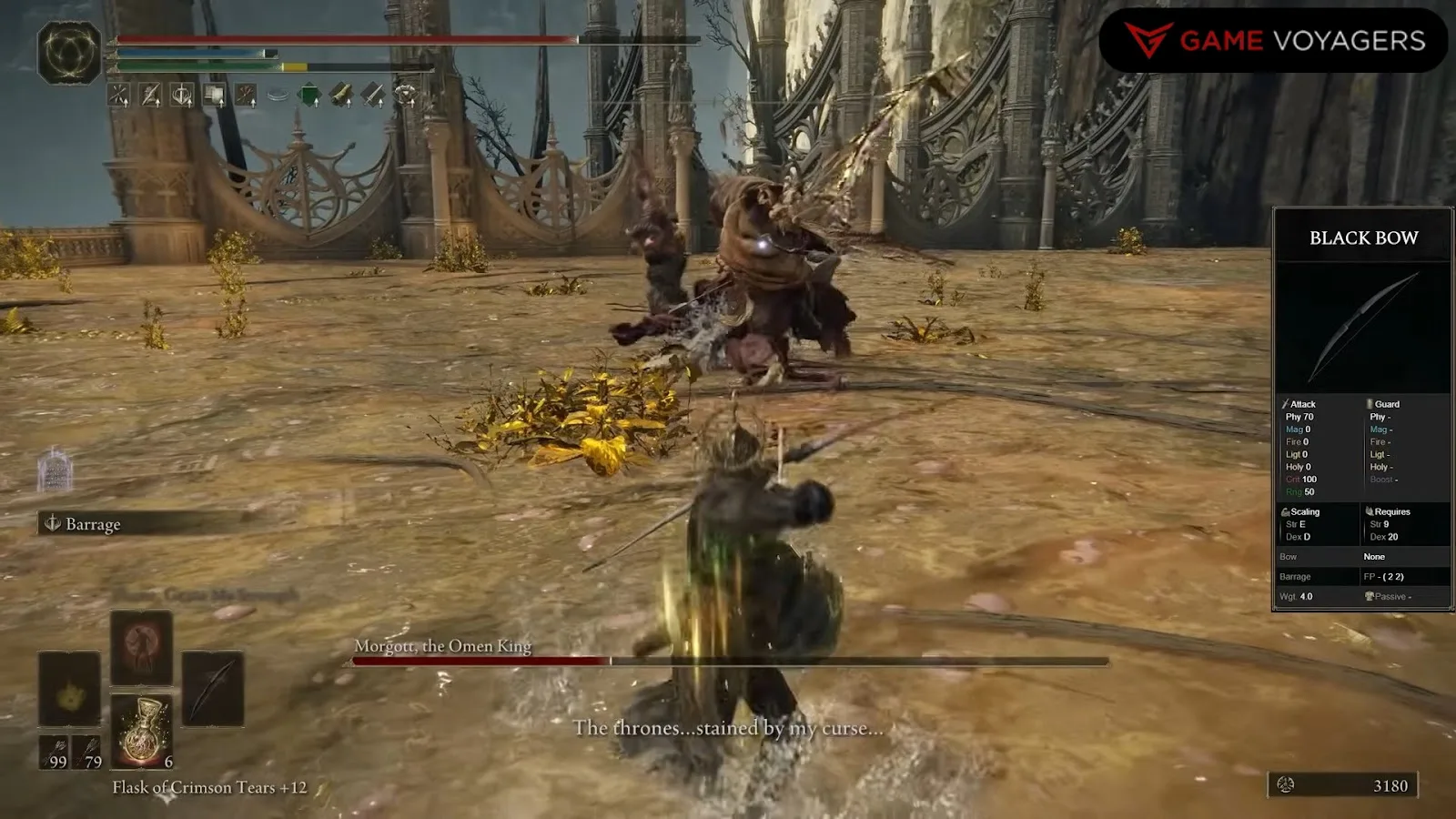
The Black Bow is a medium bow with the lowest damage in its category, but it has a unique advantage: It has the light bow moveset, which gives it the mobility and fluidity of a light bow.
The Black Bow stands out if you’re looking for quick, agile combat with combos like jumping into landing or rolling attacks. The result is a bow that feels more nimble and responsive than other medium bows, and in PvP fights, it’s superior to most light bows due to its ability to deal more damage while maintaining that fast playstyle.
Despite these advantages, there are still a few reasons I’ve placed the Black Bow lower on the list. First, it can’t be infused, and it’s locked with the Barrage skill, which I feel is a letdown compared to the versatility of Rain of Arrows. The latter skill allows you to melt larger bosses, making it more useful in many situations, whereas Barrage feels more situational and less dynamic.
Another reason for the lower ranking is that, after the DLC release, we now have the Ansbach’s Longbow, another medium bow with the same moveset as the Black Bow but with better damage and much stronger skill. This makes the Black Bow feel a little outdated.
Bone Bow
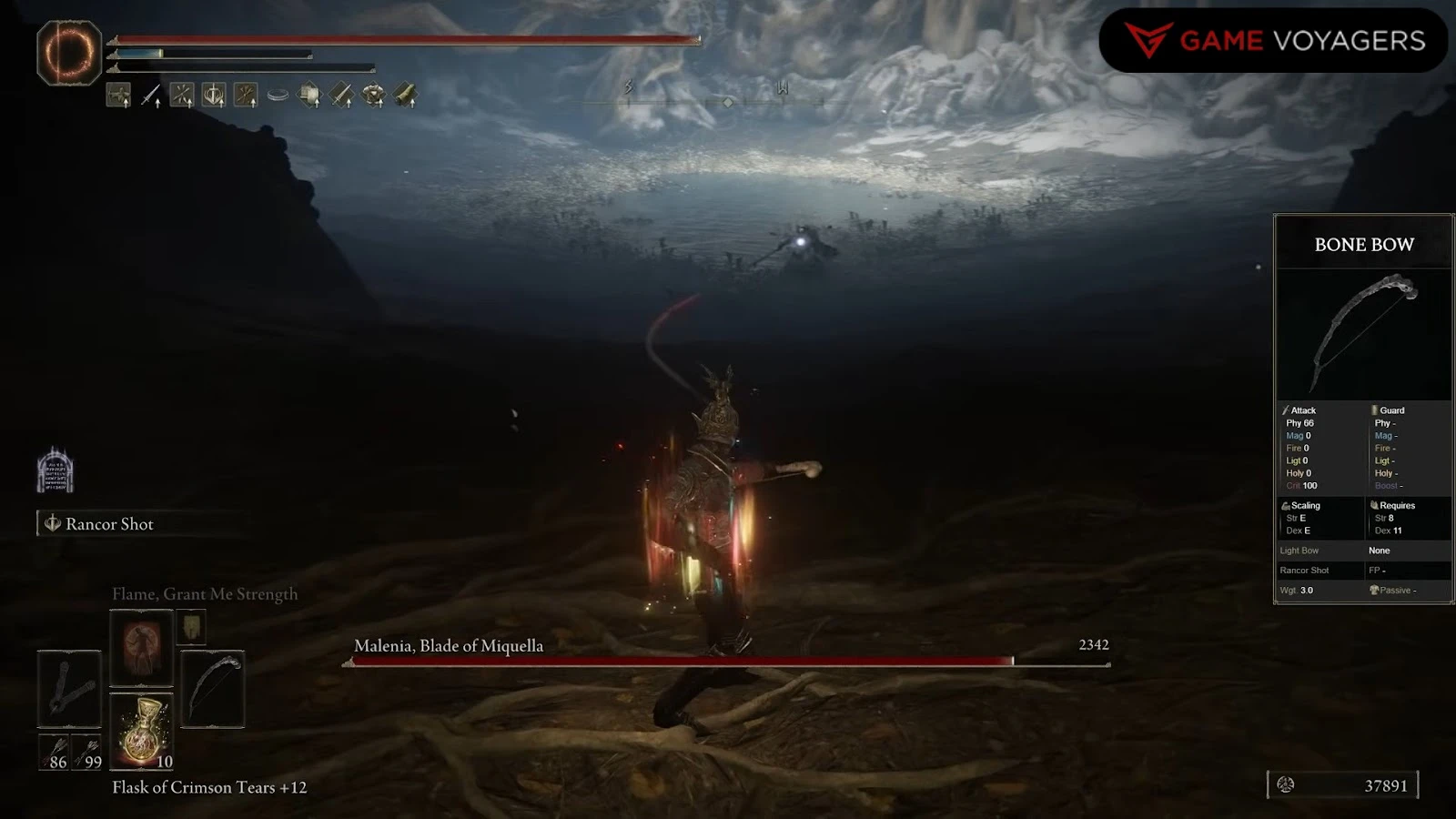
The Bone Bow, introduced in the Shadow of the Erdtree, is a light bow that, while it doesn’t have the most incredible damage, compensates with a unique skill: Rankor Shot.
This skill is a reskinned version of Barrage, where the bow fires arrows quickly. What sets it apart is the greater damage and incredible range of Rankor Shot, thanks to its insane homing ability. It’s effortless to use, especially against enemies that constantly dodge or move around, as the skill tracks them consistently.
However, the Bone Bow suffers from a significant nerf in status effect buildup. After a patch released with the DLC, the status buildup from Rankor Shot became severely limited, making it nearly impossible to proc effects like Bleed. Even against basic bosses, it could take up to 60 arrows to proc bleed, which is a stark contrast to its earlier OP potential.
Given this, it becomes hard to justify using it for status effect builds, especially when you can proc status effects much faster with regular bow attacks.
A Tier Bows
The subsequent bows can be utilized as a primary weapon. These bows could work wonders with a bit of setup and build crafting. These are the best bows in Elden Ring for a myriad of reasons:
Pulley Bow
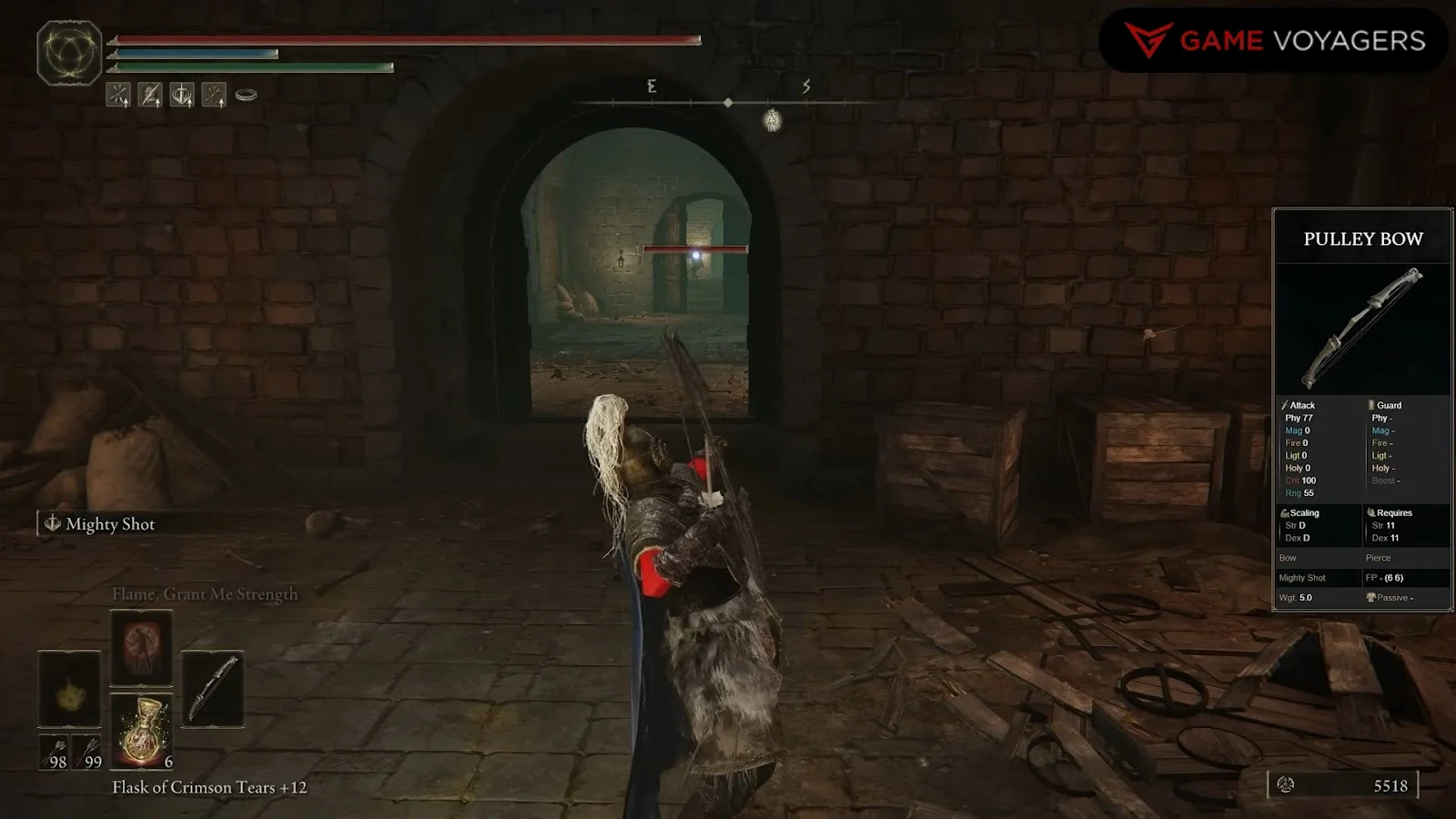
The Pulley Bow is the highest-damaging medium bow in Elden Ring, and it comes with a boosted range that can rival or even exceed that of some greatbows. This makes it a very versatile option, capable of hitting targets from further away without sacrificing too much damage.
The main downside of this bow is that it’s stuck with Mighty Shot, a sniping skill that, while helpful, limits its overall utility.
As for raw sniping potential, greatbows once again outclass the Pulley Bow. Still, the latter’s lighter weight and lower stat requirements give it an advantage for players who don’t want to invest heavily in attributes like Strength or Dexterity. With only 11 in both Strength and Dexterity required to wield it, the Pulley Bow provides an option for sniping without committing to a heavy build.
Composite Bow
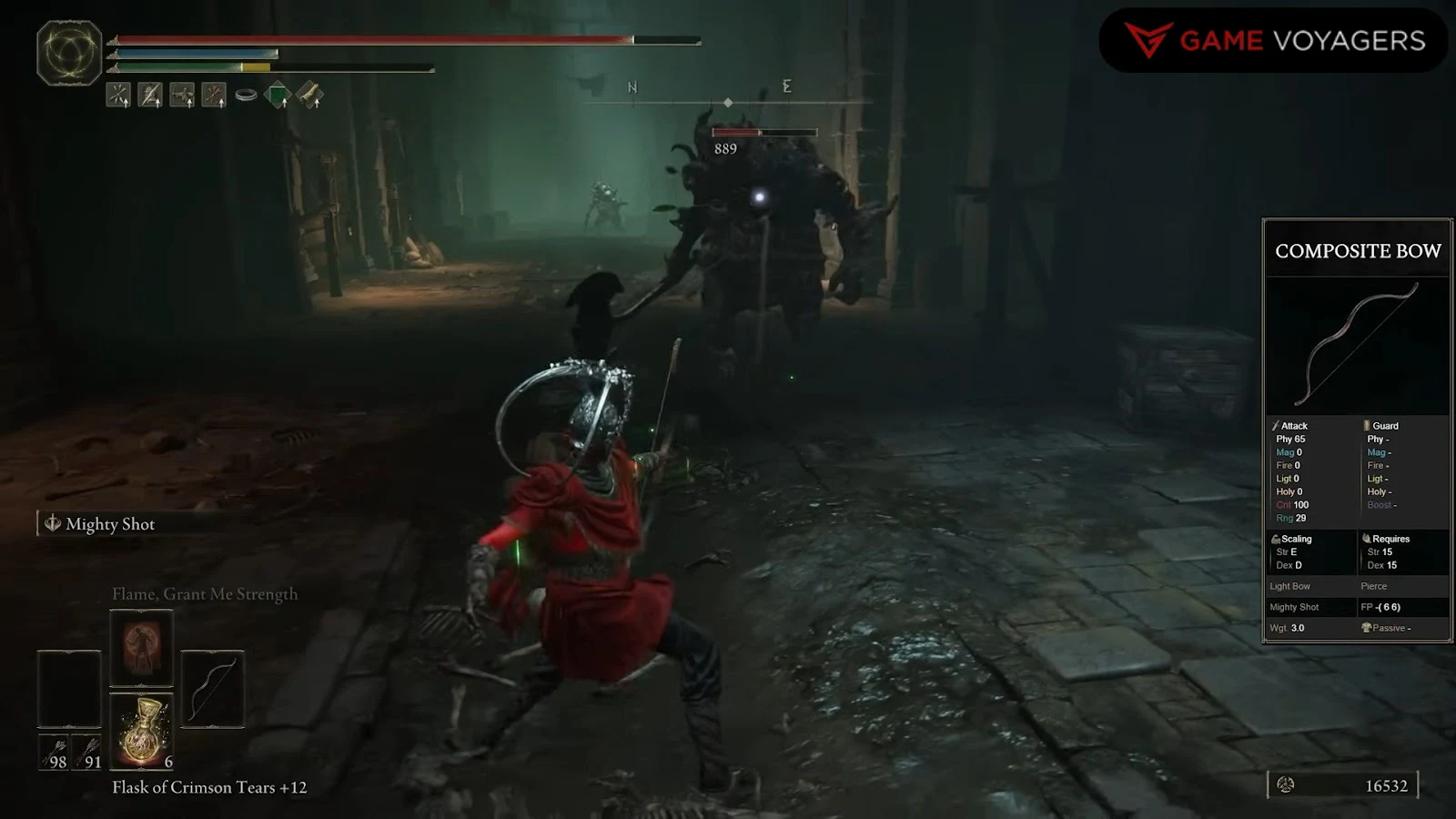
The Composite Bow is one of the best options for players who want to focus on a primary bow-based build in the base game. While bows typically serve as secondary weapons, ideal for sniping, kiting enemies, or dealing damage to large bosses from a distance, the Composite Bow excels in various situations thanks to its moveset.
The light bow moveset is versatile and works well in almost any combat scenario, especially in 1v1 fights against quick enemies. With its fast attack speed and the ability to chain jumping attacks into landing attacks, it becomes an excellent choice for players who want to stay mobile and deal consistent damage. On top of that, its low weight and minimal stat requirements make it easy to use right from the start of the game.
What sets the Composite Bow apart is its ability to be infused with different Ashes of War. For instance, equipping Rain of Arrows makes it a mighty weapon for taking down larger bosses.
Combining this speed, flexibility, and damage with the realization that you can get this bow exceptionally early on makes the Composite Bow an excellent all-around choice, whether in the early game or further into your playthrough.
Greatbow
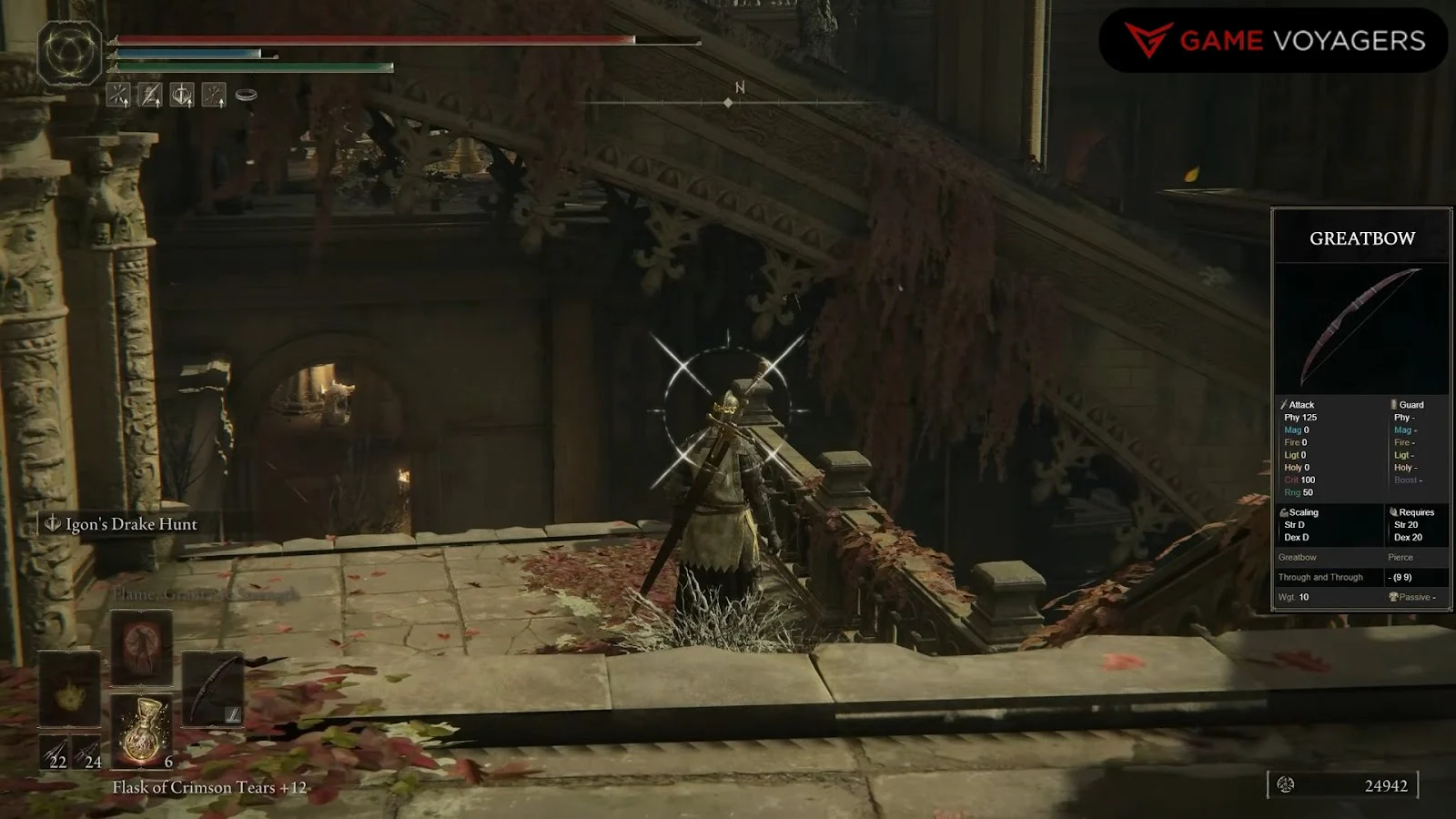
The regular Greatbow is one of two infusible greatbows and offers superb damage potential, especially with some investment in Dexterity. Its scaling leans toward a quality build, which makes it an ideal projectile option for said builds, as they often lack access to seals or staffs for ranged combat.
The Greatbow gets a leg up due to its ability to be infused, granting flexibility with sniping and boss-melting strategies. Skills like Through and Through or Egon’s Great Hunt enhance its utility as a sniper, while Rain of Arrows makes it a formidable weapon against ginormous enemies/bosses.
However, a few downsides keep it from ranking higher. For players focused on a Rain of Arrows setup, the Lion Greatbow outperforms it, and for sniping at earlier levels, the Golem Greatbow delivers higher damage. Still, in later stages, particularly in New Game Plus, the regular Greatbow paired with Egon’s Great Hunt may become the superior sniping choice.
Golem Greatbow
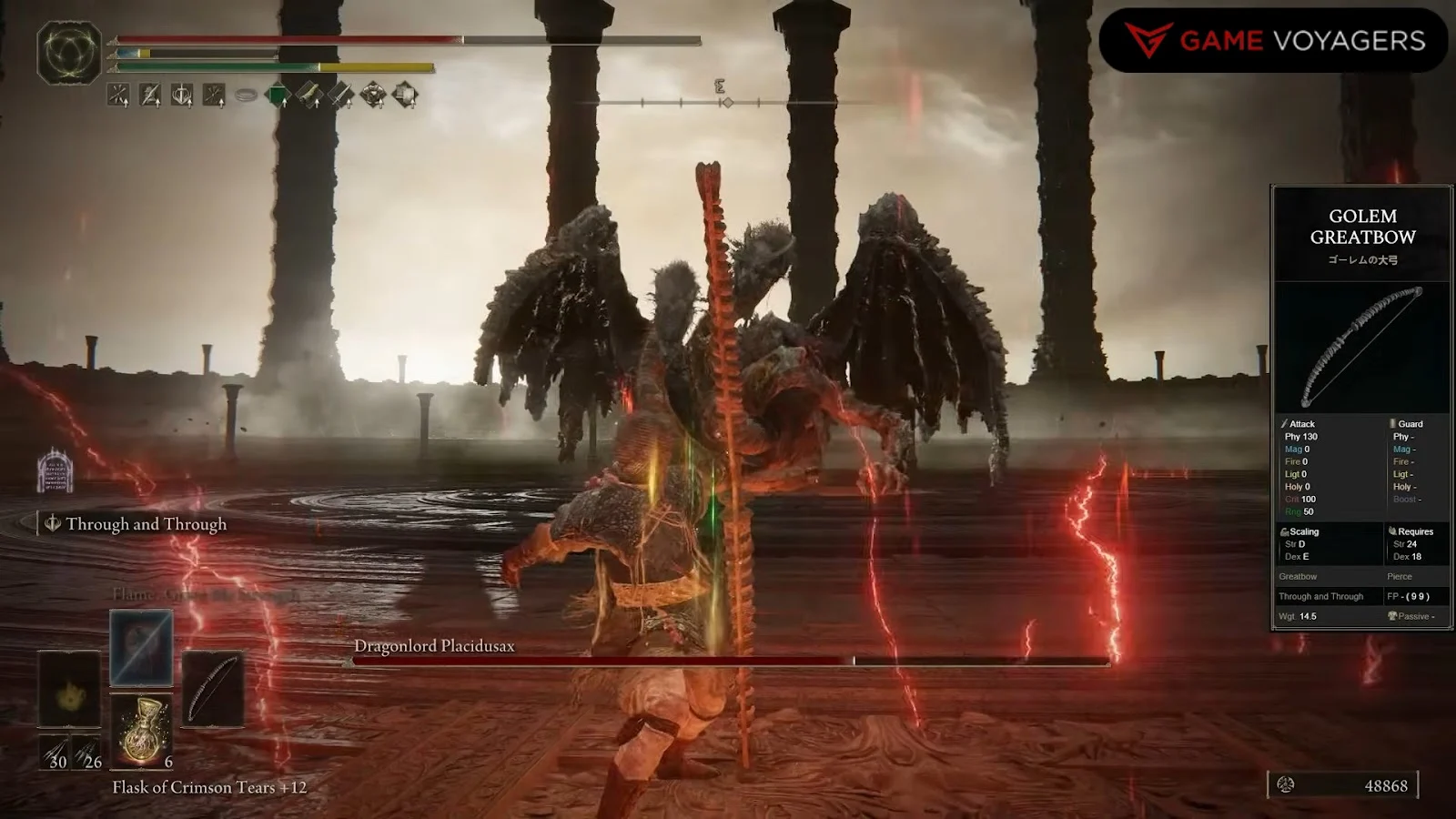
The Golem Greatbow boasts the highest attack rating (AR) among all bows, comfortably awarding it the best sniping option in Elden Ring. It comes with the Through and Through skill, which offers serious damage and can pierce through multiple enemies, especially more enormous bosses. This skill shines when paired with the Golem’s Great Arrows by delivering numerous hits in a single shot.
That said, Rain of Arrows or the Lion Greatbow are usually better choices for boss fights. The Lion Greatbow, in particular, can deal even better damage when using Radahn Spears.
While the Golem Greatbow excels at sniping, the release of the DLC introduces Egon’s Great Hunt, which provides a more potent sniping alternative. Although Egon’s Great Hunt doesn’t pierce like Through and Through, it deals significantly higher damage per hit. At higher levels, equipping this skill on another Greatbow can outperform the Golem Greatbow in terms of raw damage.
Despite these considerations, the Golem Greatbow remains a top-tier choice due to its early accessibility, Somber Smithing Stone upgrades, and sheer power early in the game.
Lion Greatbow
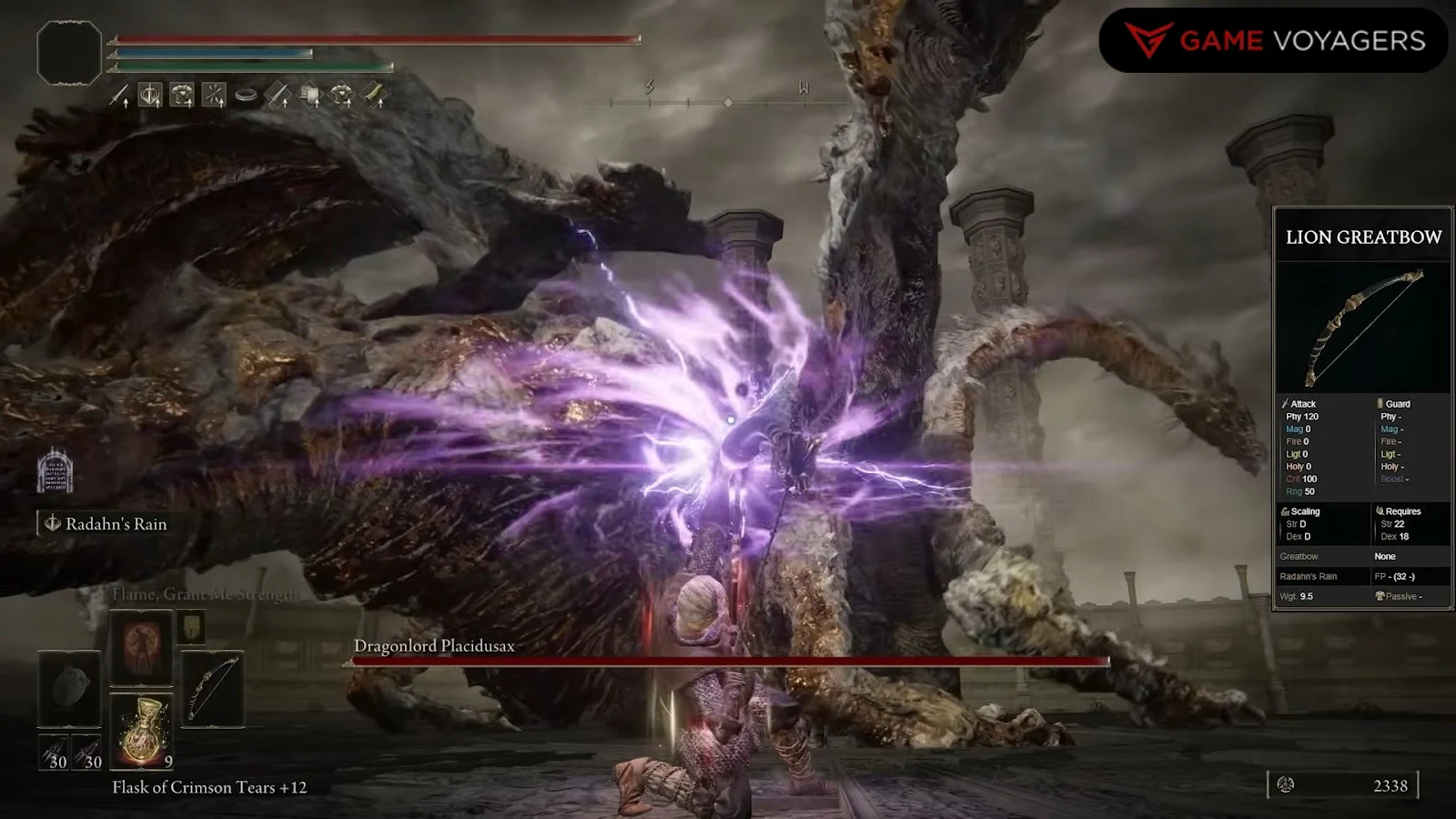
The Lion Greatbow is THE BEST GREATBOW in Elden Ring. While its attack rating doesn’t reach the Golem Greatbow’s heights, equipping Radahn Spears boosts its damage by 20%, easily surpassing the Golem Greatbow in specific scenarios. If you dual-wield Lion Greatbows, you can even stack passive effects for more tremendous damage potential.
Its skill, Radahn’s Rain, is essentially an enhanced version of Rain of Arrows, firing approximately 50% more arrows than the original, thus resulting in more damage output. For this alone, the Lion Greatbow is especially lethal at melting bosses, particularly when paired with Radahn Spears.
However, its trade-offs include a higher FP cost (12 more than Rain of Arrows) and the expense of Radahn Spears, which can quickly drain resources. A regular Greatbow with Rain of Arrows may be a more efficient choice for quality builds with lower Mind stat. Nevertheless, the Lion Greatbow’s unique capabilities cement its status as the best Greatbow for boss fights, even if it isn’t without flaws.
Ansbach’s Longbow
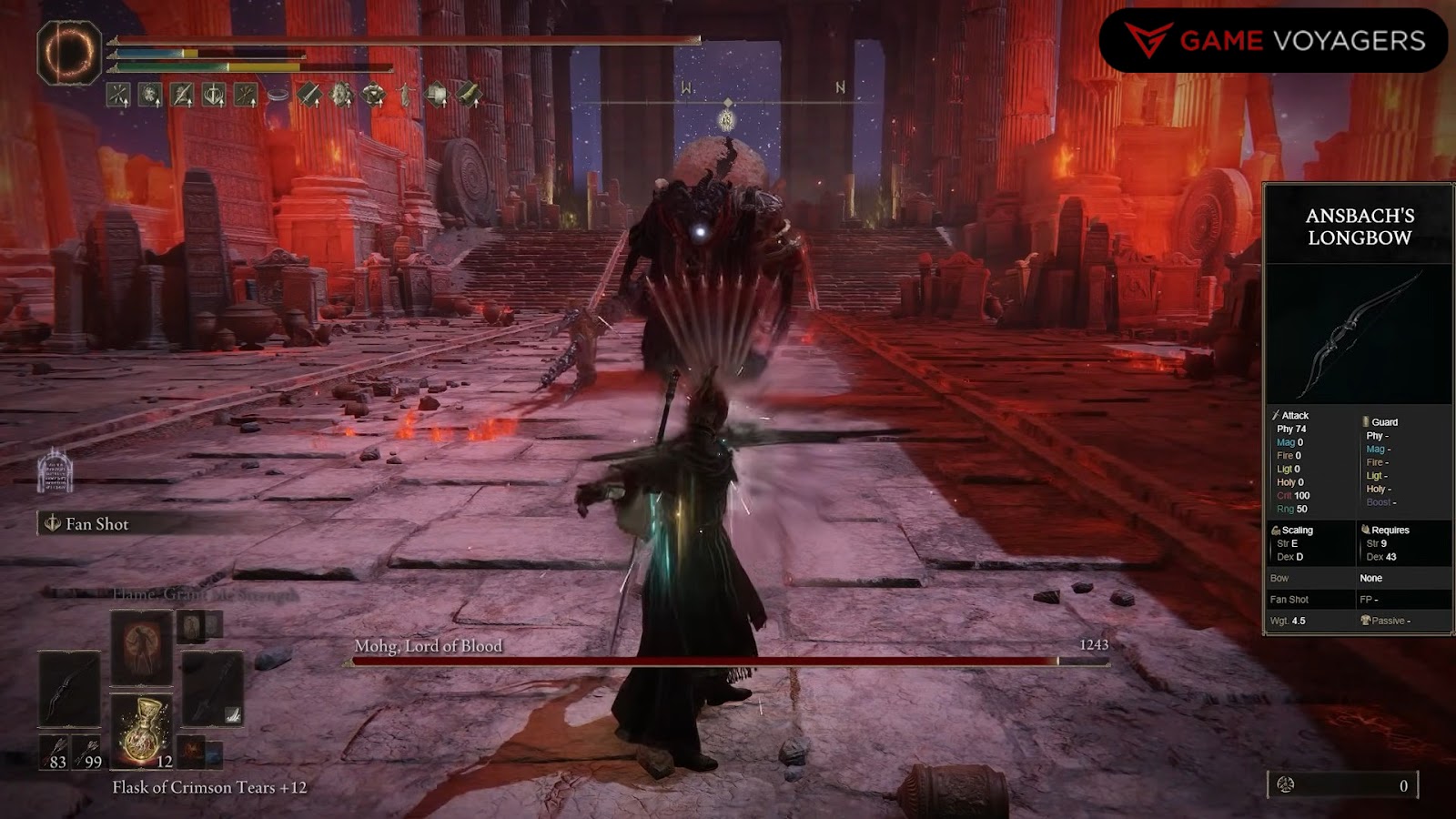
Ansbach’s Longbow is a medium bow with some of the lowest damage in its class. However, it more than makes up for this with the same moveset as a light bow, allowing for fast, breakneck combos. This combination of medium bow damage and range with the light bow’s speed makes most other light bows obsolete in Elden Ring.
The highlight of Ansbach’s Longbow is its skill, Fan Shot. For just 11 FP, it fires eight arrows at once, delivering massive burst damage. Unlike many bows, which can feel underwhelming due to their slow, incremental damage, Fan Shot lets you deal vast chunks of damage instantly.
This transforms the Longbow into a weapon capable of staggering enemies, hitting multiple foes, and efficiently taking down both large and small bosses.
Fan Shot can dish out devastating damage with proper setup like using the Arrow’s Sting Talisman making pure bow builds feel more viable than ever. Point-blank range or long distances, it has everything covered.
Despite its strengths, Ansbach’s Longbow suffer from bow’s general lackluster scaling. Additionally, Fan Shot consumes eight arrows per use, which can quickly deplete your ammunition.
While not perfect, Ansbach’s Longbow is still the best bow in the game, combining speed, power, and versatility in a way that redefines bow gameplay.
There aren’t any “S Tier” bows in Elden Ring. No bow in this game is broken like the Blasphemous Blade. Their overall lack of scaling and other missing “x” factors don’t tend to make them the cornerstone of any build. Nevertheless, as you can see, many bows in Elden Ring can hold their own if you know how to build around them.

